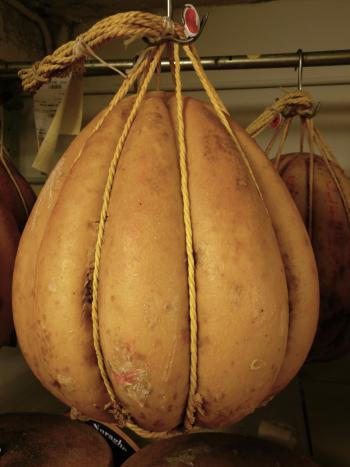Provolone
- Producer
- Various
- Country
- Italy
- Region
- Various
- Size
- Various
- Website
- Milk
- Cow
- Classification
- Semi Soft
Firm
Hard - Rennet
- Microbial
- Rind
- Waxed
- Style
- Pasta Filata (mozzarella-type)

It might be a ubiquitous selection at the deli counter, but there's a whole lot more to this cheese than you might expect. Although now imitated in other regions of the world, true provolone originated in southern Italy, near Naples, and later spread to Lombardy and Veneto in the north. Today the OG versions from those respective regions—Provolone del Monaco and Provolone ValPadana—have geographic indications that protect the production region and process as well as the names.
Here's another surprise: Provolone is a cousin of mozzarella. Both are made in the style of pasta filata, which means “spun paste” in Italian—aptly named because these cheeses undergo a unique stretching process that gives them a characteristically stringy, stretchy quality. The process begins with the customary steps: The milk is curdled, the curds are cut into pieces, and the whey is drained off. But then it gets fun. The next stage is the filatura (spinning). Curds are steeped in a bath of very hot whey or water. When they begin to float, it’s time to drain off the liquid. The curds are then mixed and kneaded until they achieve a soft, stringy texture. The mass is then divided into smaller cheeses, often by forming balls or pulling out a thick strand and chopping it, much like a taffy pull. Some versions, like mozzarella, are sold fresh. Others, like provolone, are aged.
Regardless of its starting shape–either a ball, a pear, or a long sausage–provolone is often distinguished by its deep, sculpted depressions thanks to the rope from which it hangs. Although months’ worth of gravity would shape any cheese, provolone is particularly affected because that stretching renders it malleable. Even as it becomes dry and crumbly, there's a softness that lasts through the aging process.
Traditional Italian provolones are aged minimum of four months and flavor of the cheeses varies from the dolce (sweet) version with a mild taste to a sharp, tangy piccante version yielding more pronounced, assertive flavors.
Tasting Notes
The smooth, pale yellow rind of provolone is generally not eaten. The interior paste of the cheese is also pale yellow, becoming darker with age. High-quality versions boast a dense (but not rubbery) paste and a subtly nutty flavor. And while most of us know provolone as turkey’s mild, milky sandwich partner, the cheese becomes more complex with time—aged up to three years, provolone piccante takes on a sharp, almost spicy quality as it matures and is best served on a cheese plate or grated over pasta.
Pairings
Provolones are great melters, thanks to the way their curds are stretched and pulled during the make process; try incorporating them into one of our recipes.



